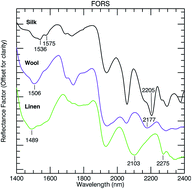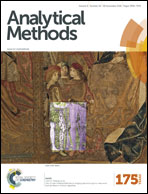Use of near infrared reflectance imaging spectroscopy to map wool and silk fibres in historic tapestries
Abstract
The analytical identification of natural fibres such as wool and silk in historic tapestries is often done by visual inspection of fibre samples using polarized light microscopy. Identification of these fibres, however, can be achieved in situ by comparing vibrational features in the near infrared (2000 to 2400 nm), which relate to the secondary structure of these proteins. Specifically, the vibrational combination features associated with the amide A, II and III groups in the 2100 to 2400 nm spectral region can be used to separate the α-helix structure (wool) from β-sheet (silk). Overtones of these vibrational features in the 1500 to 1600 nm range have also been found to be a useful marker for β-sheet and α-helix content. Here we demonstrate how these overtone features can be used to separate and map wool and silk fibres in two tapestries, The Mazarin Tapestry (c.1500) and The Procession to Calvary (1530/1550) both in the collection of the National Gallery of Art, Washington, DC. It is known that artisans use the matte and shine of wool and silk respectively, along with natural coloured dyes, to create the ‘palette’ used in pictorial tapestries. Knowledge of where and how these fibres are used is of interest to conservators. This chemical method also offers the potential to map regions of degradation of silk in situ, by monitoring loss of β-sheet content due to environmental or mechanical stress.



 Please wait while we load your content...
Please wait while we load your content...